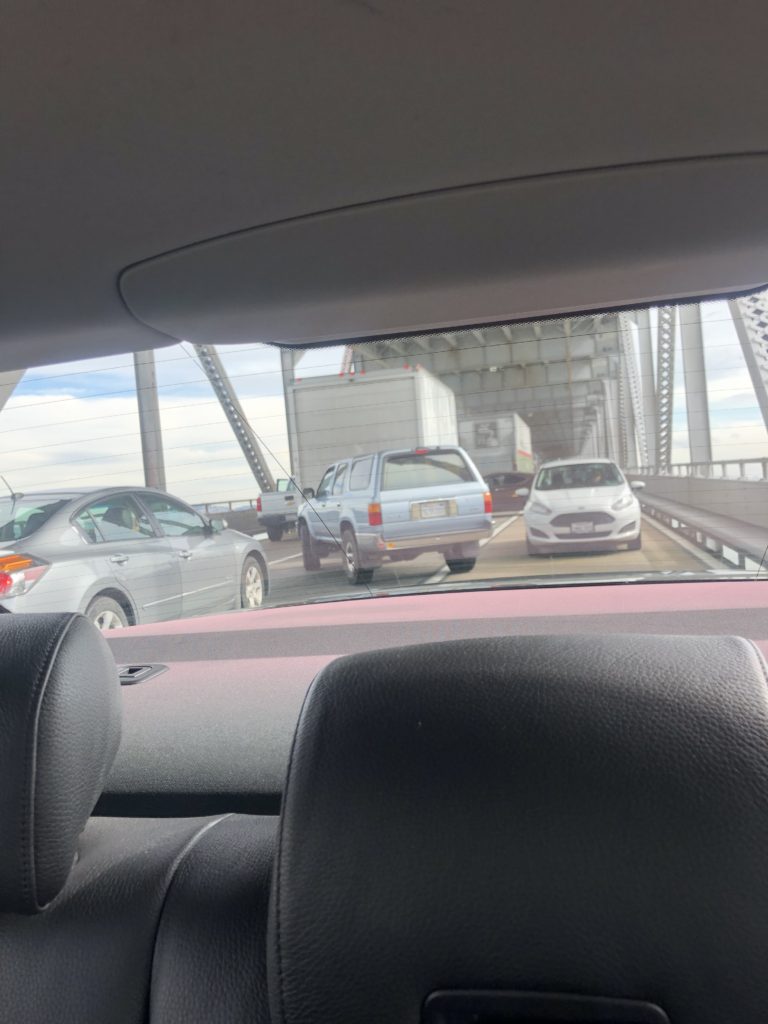Rainy weather delayed repairs to the Richmond-San Rafael Bridge until Monday, more than a week after pieces of concrete fell from its upper deck and left drivers at the mercy of a traffic gridlock that lasted all evening.
The commuter chaos began when concrete debris struck a vehicle traveling on the lower eastbound deck of the Richmond-San Rafael Bridge on the morning of Feb. 7. Caltrans and CHP shut down both directions of traffic twice before opening all lanes later that evening after emergency repairs were made.
The ensuing traffic created huge delays all over the Bay Area with some cars remaining bumper to bumper for hours. Some drivers risked turning around into oncoming traffic to escape the congestion.
For Abolhassan Astaneh-Asl, a UC Berkeley professor emeritus of civil engineering, it was a miracle nobody was hurt by the football-sized concrete debris that day.
“The weight of the concrete hitting the cars underneath at 45 to 50 mph could be pretty dangerous. That’s a serious public safety issue,” he said.
Astaneh-Asl served on an advisory board for the 2005 seismic retrofit of the Richmond-San Rafael Bridge and said the concrete fell from an expansion joint above the lower deck.
Since the bridge is not a single continuous slab, it is held together every 100 feet or so by an expansion joint. These expansion joints expand and contract as temperatures rise and fall, but also receive the most wear and tear from vehicles, he said.
“What damages the bridges are loads of trucks. When trucks are driving over the bridge and get to the expansion joint from one slab to the other slab, that impact causes stresses on the deck,” he said.
As one of the leading engineering experts on steel, Astaneh-Asl also investigated the World Trade Center site after 9/11. The older lightweight concrete used at the World Trade Center was brittle and similar to the type used for the Richmond-San Rafael Bridge back in the 1950s. While lightweight concrete on the bridge’s upper deck puts less stress on the structure, it is also extremely fragile.
“When the [World Trade Center] floors started collapsing, the lightweight concrete became a powder,” he said. “If you hit it with a hammer, it just shatters.”
Public highway bridges must be routinely inspected at least every 24 months for wear and tear, according to Federal Highway Administration spokesperson Nancy Singer.
“Before this thing broke, there must have been some cracks,” Astaneh-Asl said. “If an inspector says the expansion joints need repair or replacement, this should have been prioritized.”
An inspection last August found no flaws with the expansion joint responsible for dropping concrete, according to Caltrans.
“[The] Richmond-San Rafael Bridge is over 60 years old,” Astaneh-Asl said. “It would be great if Caltrans could replace the deck with a new concrete deck, but they have to prioritize. It costs a lot of money.”
The Bay Area Toll Authority spent $46 million on Richmond-San Rafael Bridge maintenance and budgeted an additional $80 million for the same work over the next decade. It is possible both decks may need to be completely replaced in the next 10 to 20 years, according to Metropolitan Transportation Commission spokesperson John Goodwin.
“It’s not unusual for there to be a joint problem on the bridge. Over the years, hundreds of different joints have been replaced on the bridge,” Goodwin said. “It’s 63 years old. It was kind of built on the cheap if you will back in the mid-1950s.”
The bridge averaged 72,000 cars per day in 2013 compared to 82,000 cars daily in 2018. The increased traffic combined with heavier trucks and aging infrastructure put additional stresses on the expansion joints, according to Goodwin.
“The bridge carries a lot more traffic now than it did back in those days,” he said. “The impact is felt by so many vehicles, not only on the bridge, but all around the region. There’s less capacity, less slack in the system.”
Caltrans engineers installed a temporary 8-foot metal plate on the upper deck of the bridge where concrete broke off from the expansion joint. Permanent repairs will take at least two weeks, according to Caltrans spokesperson Vince Jacala.







